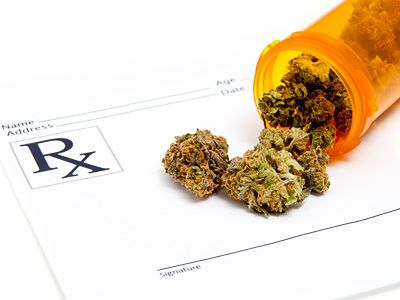Psychiatry
Medical Marijuana for Psychiatric Disorders
Can a joint a day keep the psychiatrist away?
Posted March 11, 2013

Medical Marijuana for Psychiatric Disorders
The following is a transcript from the podcast Optimal Living with Dr. Jeremy Spiegel available at www.cascobaymedical.org.
Welcome to Optimal Living. In today’s podcast I’m going to make the case for medical marijuana in the treatment of psychiatric disorders.
First I want to give you a general defense of medical marijuana. Then, I’ll tell you what I’ve seen in my own practice. Finally, I will explain in brief three studies, two for anxiety and one for depression where medical marijuana has been of great benefit.
It’s generally true that little stories, one specific case after another, add up to an enormous amount of what we call anecdotal evidence. And in medicine anecdotal evidence is often sufficient to guide treatment, or at the very least, to initiate further investigation. In the case of medical marijuana, and contrary to the belief of many physicians, much of that investigation has been already done.
So does your own doctor know about the research?
Marijuana as a treatment has not been studied by them due to political factors. Which, ridiculous as it sounds, is like a scientist shunning a particular chemical system in the body for reasons that have nothing to do with science.
Imagine a family practitioner who in his total person evaluation of a patient skips over the organs which exist ‘below the belt’ because when activated they have some tendency to cause people to feel different from how they are when they’re, say, quietly waiting on line at Chipotle. The sex organs might make these same people joyful even. The might giggle. They could feel tightly connected to another person. Just imagine that whole bodies of information should vanish, the specialties of Urology and OBGYN, much maligned due to the stigma of these other effects of these potentially consciousness expanding sexual organs.
Consider this. The anti-medical marijuana lobby contends that because pot has been used recreationally it has no place within medicine’s treatment armamentarium. Clearly this kind of argument bears little merit since marijuana has not only wide clinical application, but because certain strains and formulations may be targeted towards the specific conditions warranting therapeutic effects, say, Crohn’s Disease, or glaucoma.
Not to mention, such a naïve and reactive view ignores a natural and critical regulating system which every human body has built in to our physiology—the body’s natural cannabinoids and cannabinoid receptors—the endocannabinoid system. This system—even in the total absence of marijuana plant material—regulates modd, memory, appetite, and pain sensation. The plant-based or what’s called phytocannabinoids merely serve to enhance these already present processes in the body.
Let me give you two brief examples of cases that I’ve encountered in my practice over the past year.
There was a young person in my Boston area office who suffered needlessly owing to the fates that gave him a cancerous tumor in a place that is very difficult to get to surgically. Yet his world-class physicians at a premier medical center pooh-poohed the idea of his use of marijuana as medicine.
Why should this be? If his prejudiced doctors were blind to this medicine’s much maligned past and route of administration—in this case vaporizing—they would be ecstatic that there were something their patient could take to improve his diminished appetite, chronic nausea, demoralizing pain, as well as—to be honest—the will to live.
I’m really not sure why the doctors were so nervous about the use of medicinal marijuana.
In another case I had a patient who had been on multiple agents for depression, the usual medications we employ when talk therapy just doesn’t seem to operate fast enough to reverse the lack of appetite, flagging energy, bankrupt motivation, and dark moods which take hold of a person and don’t let go until they’re curled up in bed all day with thoughts of death, unable to function at their job or in their relationships.
After years of feeling like a human guinea pig having been switched from one medicine to another, combining a few and suffering the slings and arrows of medication side effects and even antidepressant withdrawal symptoms, she decided to use medical marijuana to treat her depression and anxiety. And while yes, of course, she is the same person she always has been—struggling with the same issues around love and neglect and abandonment—her moods, motivation and outlook are significantly improved by daily use of marijuana.
As soon as my eyes became open to the possibility of marijuana’s capacity to improve depression in some people, I began to see more and more of it. I permitted my own years-long prejudices to move aside so that I can see more clearly what is right before my eyes.
In fact, cutting edge medicinal marijuana research suggests a joint a day might keep your psychiatrist away.
In a study published by researchers at University College London in a January volume of Psychopharmacology researchers showed forty-eight human subjects a colored box. Shortly after seeing the box, they were given an electric shock. It’s no surprise that after a few rounds of this small torture, just the sight of the box itself could easily elicit a physical fear response in the participants. The fear would come with the box, even if the shocks no longer followed.
In this study the researchers employed this technique called classical conditioning. Let’s review for a moment. Remember those dogs, Pavlov’s dogs, you learned about in Psych 101? Pavlov classically conditioned dogs to salivate upon hearing the ringing of a bell. Under usual conditions dogs salivate when they’re about to eat food. But because by ringing the bell at feeding time, ringing began to be tightly associated with the presentation of food, you could at some point remove the food from the equation and you’d still get the dogs to salivate.
Now, once you’ve conditioned the dogs to do this, removing this response is called extinction. And there are different ways to achieve extinction. In this marijuana study the researchers wondered if by administering to the human subjects a major constituent of marijuana, cannabidiol, or CBD, if extinction could be more robust and sustained. In other words, can CBD from cannabis undo the fear, the anxiety, the physical response to the conditioned stimulus? The answer from this research was an unambiguous ‘yes’.
CBD from marijuana was able to successfully maintain extinction in this study which had a double blind placebo controlled design. As psychiatrists we are very careful to say something works as a therapy especially if it passes the standardized test of double blind placebo controlled trials. If a medicine passes this test we can safely prescribe the medication and feel secure about it.
For some medical marijuana is helpful, not curative. But others have been able to completely eliminate their dependence on other medications altogether.
Think about it, though. If you closely examine the use of conventional treatments, you will notice the same distribution, the same bell curve. There are those for which a single medication, what we like to call monotherapy, is effective; others need augmentation with additional medications; and some squeak by with a lessening of symptoms but far from what might be called a vast improvement. It’s no different with medical marijuana than it is with the standard canon of psychopharmacological agents.
When we see nicely designed scientific clinical studies it’s impressive because someone took time and put thought into its design to yield information we hadn’t had prior to the study’s implementation. From this the authors generally suggest the next step to take for further research based on the outcome of this original one.
Let me just mention another study involving anxiety. This one is from 2008 involving subjects whose brains were scanned by a special type of MRI, the administration of a primary constituent of cannabis, specifically THC, significantly reduced the anxiety and extinguished fear in subjects who were exposed to pictures of threatening faces. The activity of a part of the brain, the amygdala, which is involved in recognizing threat and processing fear, was significantly reduced with the presence of THC.
Let me put this into some context.
Researchers use functional imaging so they can study activity in parts of the brain under certain conditions. When a threatening face is shown to a subject, the activity in the amygdala increases, the image on the screen brightens so you can see physically a direct correlation between an emotional state and what’s going on in the brain.
So if the activity increases naturally under the specific circumstance of seeing a picture of a threatening face, then logic would have it that something with an anxiolytic or soothing, calming effect, should reduce that activity. And that’s precisely what the THC from marijuana does.
Anxiety is one thing, and even skeptics of medical marijuana within the medical community might allow that cannabis has a significant anxiolytic effect. But depression? That would seem to be another matter entirely.
Yet it isn’t much different at all.
One impressive piece of evidence for marijuana’s benefit for depression comes to us from a 2006 study published in the journal titled Addictive Behaviors. Here researchers compiled data from over four thousand questionnaires of depressed patients and marijuana users, and determined that those who smoked daily or even less often, also reported less depressed mood and more positive affect than non users.
Here is where the beginning of a new understanding emerges. What I mean is, that if you expect that depression only improves by certain methods, you might begin to make excuses for why what we’re seeing in the study couldn’t actually be. Yet if you judged data with an open mind you might then be able to recognize a pattern emerging of people whose moods improve with regular use of medical marijuana. A mind closed to even this possibility will guarantee you’ll remain forever blind to it irrespective of the data.
It’s true, anecdotal evidence for marijuana’s benefit in psychiatric disorders is by itself useful to guide us to try using it for intractable disorders, that is, when conventional treatments have already been tried but were inadequate in their effectiveness.
But as more and more scientific evidence of marijuana’s benefits emerges, the reasonable and judicious clinician can feel increasingly comfortable utilizing this medication for very specific psychiatric disorders, either adjunctively—as an add on therapy—or as sole treatment.
Science, not politics or prejudice, must be our guide. We must look with our own eyes without fear or prejudice. Only then can anyone expect to receive the best treatment possible.
This has been Optimal Living with Dr. Jeremy Spiegel. Optimal Living is sponsored by Casco Bay Medical, The Northeast’s Most Thoughtful Practice.
Casco Bay Medical has offices in Greater Boston, Massachusetts, Portland, Maine and New York City. Our website is www.cascobaymedical.com.




